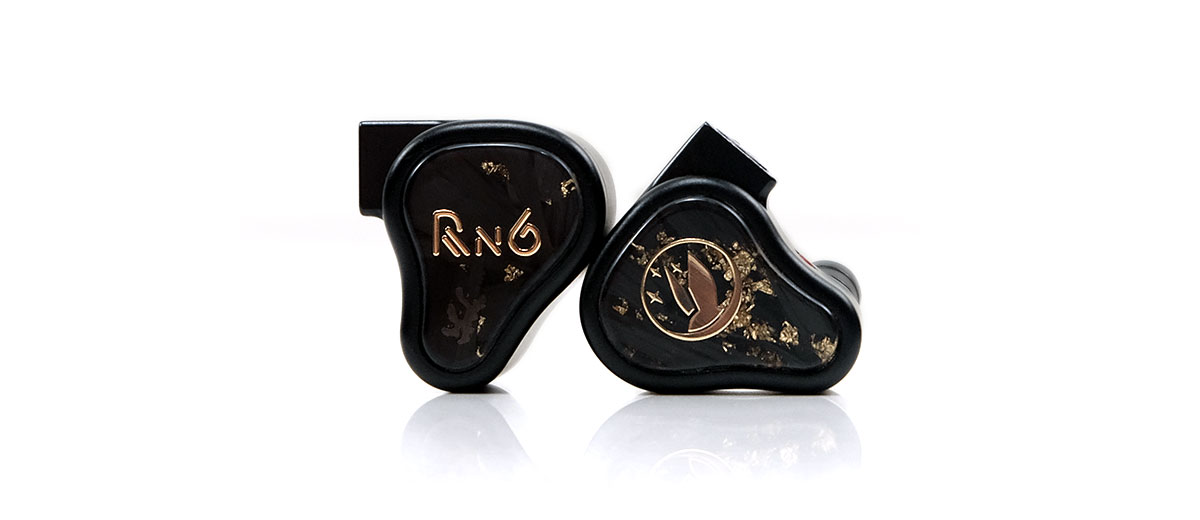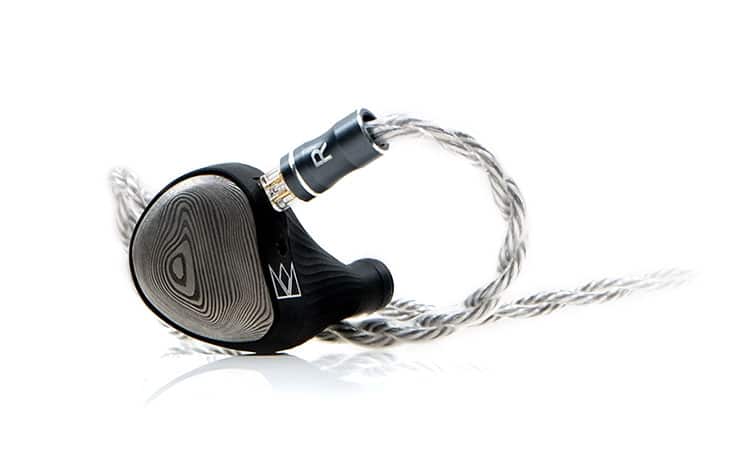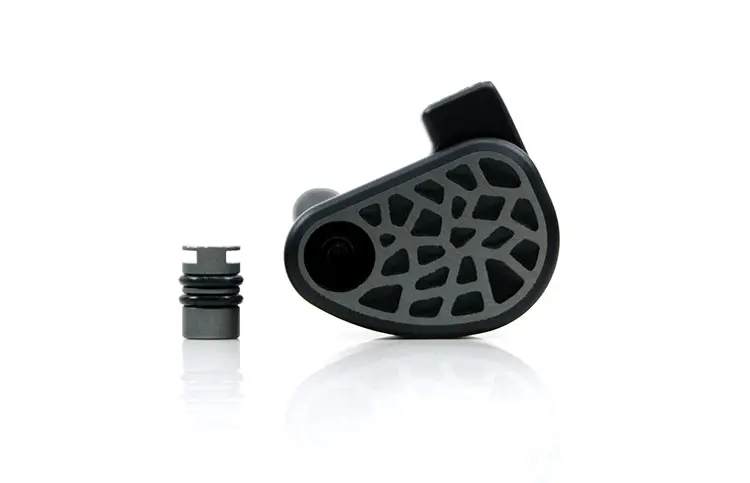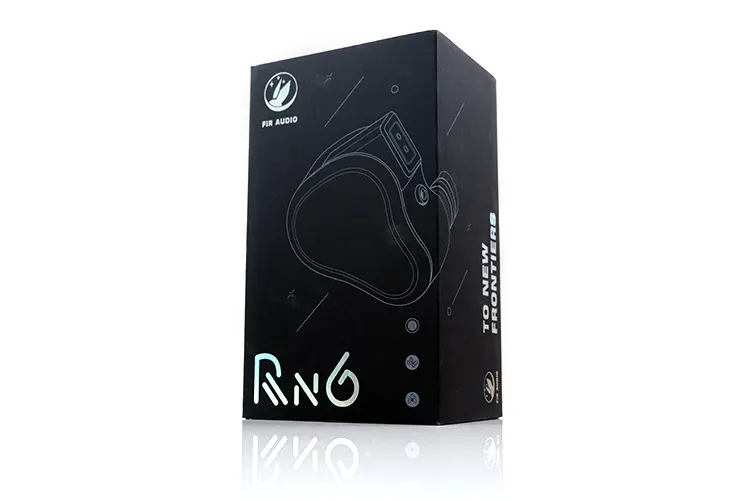Select Comparisons
The following comparisons were made using the Cayin N7, the iBasso DX320 MAX Ti, and the HiBy RS8 as the main sources. All IEMs were tested using their stock cable and tips with the Radon 6 fitted with the silver -15 dB ATOM XS filter.
FIR Audio Xenon 6
$3899
Summary
Just want to quickly start with a very brief comparison of the Xenon 6 compared to the Radon 6 using my CanJam Singapore notes since I do not have a Xenon 6 here for more in-depth comparisons.
From my show impressions, the Radon 6 sound is more neutral and cleaner than the original Xenon 6 which I A/B’ed at the booth. There is less of a mid-bass hump, better sub-bass to mids separation, and a little more upper-mids to lower-treble energy.
I preferred the midrange clarity of the Radon 6 over the warmth of the Xenon 6. I can see fans of both but for personal preference, I felt the vocal imaging was a bit more on point with more space to breathe.
FIR Audio Krypton 5
$2999
The FIR Audio Krypton 5 is the penultimate monitor in the Frontier series and comes in both universal and custom formats. It was also our Top Gear 2022 Best CIEM award winner. You can read our full review of Krypton 5 here.
Technical
Despite this sample being the custom version of the Krypton 5 there is still a heck of a lot of feature overlap between it and the Radon 6.
Both monitors use Kinetic bass, ATOM filtering, and Open acoustic technologies with some share from the Rigid Tech also such as the additional thickness on the shells and the connectors for durability.
The differences include the use of the smaller ATOM XS filter system on the Radon 6 compared to the custom design larger ATOM X system. Both operate in the same manner with similar -dB of isolation per filter but the XS system is tiny and required a HEX screwdriver to install or take out.
The driver configuration is where the major internal difference is. Both are multi-driver hybrids with the Krypton 5 a mix of a single 10mm Kinetic dynamic driver and 4 OpenDriver BAs whereas the Radon 6 adds an additional electrostatic driver on top for the ultra-highs.
I also have to note that the bass on the Krypton 5 is enhanced with one of those OpenDriver BAs to give it some additional texture and detail since that is its calling card. The Radon 6 switches the BA focus more to the mids and highs so you have 5 covering that as opposed to 3 inside the Krypton 5.
There is a slight impedance difference between the two at 28Ω for the Radon 6 and 22Ω for the Krypton 5 but it’s not huge. Where you might find a difference is in the efficiency with the Krypton 5 a little more sensitive since it does not have that Radon 6 Sonion EST energizer to power.
Design
The Krypton 5 sample we have here is a custom design as opposed to the Radon 6 universal. It would have been beautiful to get a custom version available for the Radon 6 simply because of the superior fit and higher levels of passive isolation as is the case here.
However, the Radon 6 universal is more compact and its aluminum alloy build is more durable also. Both shells are sturdy in their own way. The custom resin is thickened by 20% more than what would be considered the norm but aluminum will outgun resin shells every time in the toughness stakes.
I would take the larger ATOM X system over the minute Radon 6 XS filters used by FIR Audio for their universal fits simply to give my eyes and glasses a bit of a rest when changing them around. The fear of losing them is real.
The filters operate in the exact same manner though and are just as effective. Testimony to FIR Audio for being able to miniaturize that system to fit properly into a more compact form factor IEM.
I would rate the new cable from the Radon 6 as a step up on the current stock Frontier Series 26AWG Oxygen Free Silver Plated Copper Scorpion Wire. It’s still a 26AWG creation but the pure silver and copper shielding is a higher grade of wire material and the slicker dark brown braided jacket finish just feels more premium.
Everything else from the packaging and accessories minus the Radon 6 universal ear tips is more or less the same.
Performance
I used the silver ATOM X and XS in both monitors to keep the -dB setting and tuning tweaks consistent at -15 dB combined with the HiBy RS8 as the main source.
Hot take – the sub-bass performance of the Radon 6 is every bit as good as the basshead king from 2022, the Krypton 5 custom. Where it differs is the mid-bass bloom and the more evenly tuned but elevated mids and lower treble.
The Krypton 5 is noticeably dipped across the same range creating some softness and distance staging-wise for vocals and percussion. Of the two, it’s slightly darker sounding but still the ideal pick for those who like bass-heavy tracks.
That mids/treble lift on the Radon 6 gives the performance more sparkle, a cleaner tone, and generally a more accurate and detailed sound. The harmonic balance is better for me.
The Krypton 5’s low-end bloom from 80Hz up to almost 400Hz is more substantial so whilst I think the sub-bass on the Radon 6 is equally as strong its mid-bass is pulled back. That’s where it lacks that ‘wall of sound’ so to speak that the Krypton 5 can deliver on the lows.
The Krypton 5 is also a bit warmer and not quite as clean and separated through the mids when compared to the more neutral Radon 6. Staging emphasis is much more on the concussive bass power it can generate whereas with the Radon 6 can stretch the stage much further and wider beyond the lows.
The additional OpenDriver BAs drivers in the mids help create additional clarity on the Radon 6 but also, in turn, adds more definition to the lows from a stronger upper-order harmonic influence. This is a more precise and better-layered sound as a result.
Noble Audio Viking Ragnar
$4000
The Noble Audio Viking Ragnar is the company’s flagship universal hybrid monitor and our Top Gear 2022 Award winner for the best universal IEM. You can read our full review of the Viking Ragnar here.
Technical
Both universal format IEMs are tribrid driver configurations with the Viking Ragnar using 10 drivers in total compared to the 6 inside the Radon 6.
The Ragnar has nothing like the Bone conduction hybrid Kinetic bass system from the Radon 6 but it does use an impressive dual 10mm dynamic driver design for the lows.
You also get dual BAs for the mids, dual BA for the mid-highs, and a quad electrostatic array for the highs. The Radon 6 uses 5 OpenDriver BAs for the mids and highs but just one Sonion EST driver for the ultra-highs. It is reasonable to assume that both monitors are using 2nd gen Sonion transformers for the EST drivers.
Though Noble does not reveal much more beyond that in terms of internal acoustical engineering it’s likely this is a tubed design whereas the Radon 6 is tubeless with its Open Acoustics technology.
There is no distinct soundwave management system inside the Viking Ragnar either which the Radon 6 uses via its Atom XS filter system. There is no way to control the level of isolation to relieve pressure fatigue except through the careful selection of tips for the Ragnar.
The Viking Ragnar is rated at a reasonably 17Ω impedance and 112dB sensitivity and is slightly lower than the 28Ω rated Radon 6. Note, real-world testing with the Cayin N7 balanced shows a sensitivity gap with the Radon 6 easier to drive compared to the Viking Ragnar. So, there might be an SPL difference here in favor of the Radon 6.
Design
The Viking Ragnar is the slightly bigger of the two IEMs with a more artisanal feel to its craftmanship. The Radon 6 is smaller and more compact, and of the two it feels like it’s gone through a few more lines of industrial cutting for its aluminum body whereas the Ragnar feels shaped by human hands.
That is likely to come from Noble’s Chris Ploof partnership. One that is known for jewelry design and working with Damascus stainless steel which is at the heart of that distinctive plate design on the Ragnar.
The main shell is a ribbed 2-piece cut from a single aluminum block and given a distinctive shape and long nozzle. The Radon 6 is a CNC-machined aluminum body but finished with smooth black as opposed to being ribbed. It’s also a little more angular in its form factor but still very smooth to the touch.
One thing to note is the depth of the Ragnar nozzle which is much deeper than the Radon 6 and penetrates your canal a bit more also as a result.
You can still get them both to fit snugly and securely but the Ragnar has a slightly better level of low-frequency noise isolation. That will vary depending on the Atom XS filter you use on the Radon 6. However, with the wide port on the inside grill, it still lags a little compared to the Ragnar.
Both have excellent cables. Noble’s Magnus is a 4-wire geometry consisting of graphene, monocrystalline silver, and a copper-silver alloy wrapped inside a very soft TPU jacket with a reasonably short throw braided finish.
The Radon 6’s new darker finished cable is made of pure silver and 8-wire so the conduction levels might be superior. Both are finished with a balanced 4.4mm plug.
Performance
I think the Radon 6 performance is competitive compared to the Ragnar and that is saying something considering how much I enjoy Ragnar’s performance paired with the Cayin N7.
At a high level, the Radon 6 sacrifices some of that perceived soundstage expanse of the Ragnar, particularly the presence of the highs, to instead give you a smoother tone and a meatier instrumental and vocal note.
The Viking is notable for its stronger 5-10k sparkle and crazy good height but in return, it’s a delicate line for the harmonic balance through the mids. Noble has tuned the mids to be slightly flatter in their amplitude and forwardness to reduce any potential spikiness which also adds to the enhanced perception of staging depth and distance.
The Radon 6 does sound more intimate dimension-wise but with a more forward mids and lower treble. Combined with enhanced mid-bass bloom, it’s a smoother, slightly warmer, and fuller presentation. Not as ethereal as the Ragnar, not as airy, but possibly more emotionally engaging and natural in tone.
That Kinetic bass is firmer and more aggressive compared to the Ragnar dual 10mm dynamic drivers. The Ragnar can sound very dynamic and is more expansive in its bass staging size with a better lower-mid lift compared to the Radon 6.
However, the Ragnar lacks the comparative weight and power of the Radon 6, sounding slightly more neutral in quantity and with less of a mid-bass snap.
I would still place the Ragnar on top of the tree just for the sheer size and airy nature of its staging capability but the Radon 6 is the more natural and weightier sounding of the two.
64 Audio U18s
$2999
The 64 Audio U18s is the pro-edition spin on the popular A18t and U18t multi-driver monitors and sits just behind the flagship Fourte. You can read our full review of the U18s here.
Technical
The Radon 6 is a tribrid 6 driver setup whereas the U18s is an all-BA 18 driver per side design. The Radon 6 uses a 10mm Kinetic bass bone conduction dynamic driver for the lows, 4 BA for the mids and mid-highs, and a single EST for the ultra-highs. Whereas the U18s uses 8 BA drivers for the lows, 8 for the mids, 1 for the mid-highs, and a tia driver for the highs.
You will notice both use a filtering system for sound pressure alleviation, and passive isolation levels, as well as tweaking the sound signature.
The U18s is packed with apex whereas the Radon 6 uses FIR Audio’s smaller ATOM XS system. The dB range of isolation is slightly wider with apex starting at -10 dB up to -20 dB which is 3 dB more than the highest ATOM XS rating.
We also have an element of tubeless technology with the tia high driver inside the U18, however, the Radon 6 goes much further with Open Acoustics and an entirely tubeless acoustical design.
One notable tech inside the U18s which I am not sure the Radon 6 has a match to is LID. This stands for Linear Impedance Design and it ensures that whatever the impedance level is on any given output you plug the U18s into it should not have a low-Z skew and should play true to its correct tuning.
The U18s is rated at 8Ω and 106dB SPL compared to 28Ω for the Radon 6. Neither should be that hard to drive, however, the SPL is not officially measured for the Radon 6. In our real-world testing with the HiBy RS8, the U18s is less sensitive by about 10 steps in low gain.
Design
There is some similarity in the design language between these two IEMs but that’s no surprise given the overlapping heritage of both companies.
Both have very durable CNC-machine aluminum shells with exquisite and unique faceplates and both have perpendicular thick 2-pin connector stems to the rear of each shell.
There are some key differences with the U18s the large of the two form factors, being a bit deeper and taller but also with a narrower nozzle opening.
The Radon 6 stands out with the Kinetic bass dynamic driver grill on the inside of the shell and some of the subtler finish cues from its Rigid Technology including the snap screen nozzle guard and the 2-pin connector.
The comfort levels are not that different though the larger-sized U18s might make their presence felt a bit more in your ear but that’s about it. The U18s will isolate a bit more than the Radon 6 for a few reasons.
The first is due to it being an all-BA design with nothing like the Radon 6’s Kinetic bass system so it requires no shell venting. The second is the additional 3-dB passive isolation capability from 64 Audio’s m20 apex filter compared to the maximum of -17dB from the Radon 6 gold filter.
The stock U18s cable is good but the Radon 6 stock cable is better. The U18s uses a 48″ 8-conductor pure silver-plated oxygen-free copper wire with a 65-strand 44AWG geometry.
The Radon 6 stock cable is 26AWG and uses a higher grade of pure silver with copper shielding. Both handle beautifully with low microphonics though the Radon 6 jacket is a little firmer to the touch whereas the Premium cable braiding is looser.
Performance
For reference, both monitors had their -15 dB or silver filters fitted for a like-for-like comparison and paired with the DX320 MAX Ti.
I found these two monitors surprisingly similar in general tone, both are very natural and smooth sounding with nothing too edgy or overblown on the extremes, and two performances that you could listen to for hours without fatigue.
However, that’s not to say they sound the exact same because you will quickly pick up on what the different drivers and configurations bring to the mix.
With the Cayin N7, the U18s produces a very coherent and detailed staging quality with strong width, good headroom, and excellent spatial imaging. The Radon 6 is more intimate, not quite as complex through the mids and highs but its notes connect better with the listener.
What does that mean? Well, that Kinetic bass driver digs a lot deeper, and produces better texture and more weight which, in return, injects a better bass fundamental into both bass and mids instrumental and vocal notes.
Basically, the ‘stem’ of a musical presentation is firmer and more immediate to the listener giving it more immediacy in the performance. The U18s is more expansive, like a thinner stem but with more branches and leaves. It has less depth and sub-bass power from its BA woofer drivers despite a pleasingly punchy mid-bass response.
The U18s specialty is presenting a very coherent and highly resolving performance stage that can easily be monitored by pros without fatigue. In doing so, it might lack the thrust or dynamics of the more ‘distracting’ Radon 6 performance.
Our Verdict
The FIR Audio Radon 6 is the most complete and natural-sounding monitor I have heard from the company to date.
I can’t say with finality if I prefer it to the Xenon 6 since I have never sat down with the Frontier flagship for any length of time but my gut reaction from the CanJam comparison session was that the Radon 6 was right up my alley in terms of listening preferences.
I adore the explosiveness of the Krypton 5 bass and it has its place in my line-up for specific genres. However, the Radon 6 works wonderfully well with almost everything, especially if you want an open midrange with excellent levels of detail.
And it’s a flexible sound signature also. The combination of ATOM XS filters, tips, and source will give emphasize or diminish both the bass weight and degree of timbral smoothness depending on your preferences.
It is a pity that this is a limited edition release for now because the Radon 6 is really an excellent high-end monitor and one of my favorites since first hearing it at CanJam Singapore.
FIR Audio Radon 6 Specifications
- 1x Kinetic Bass 10mm Dynamic Driver
- 2x OpenDriver Mid BA Driver
- 1x OpenDriver High-Mid BA Driver
- 1x OpenDriver High BA Driver (with Sound Reflector)
- 1x OpenDriver Ultra-high Electrostatic Driver
- Freq. Range: 20-20kHz
- Impedance: 28Ω





